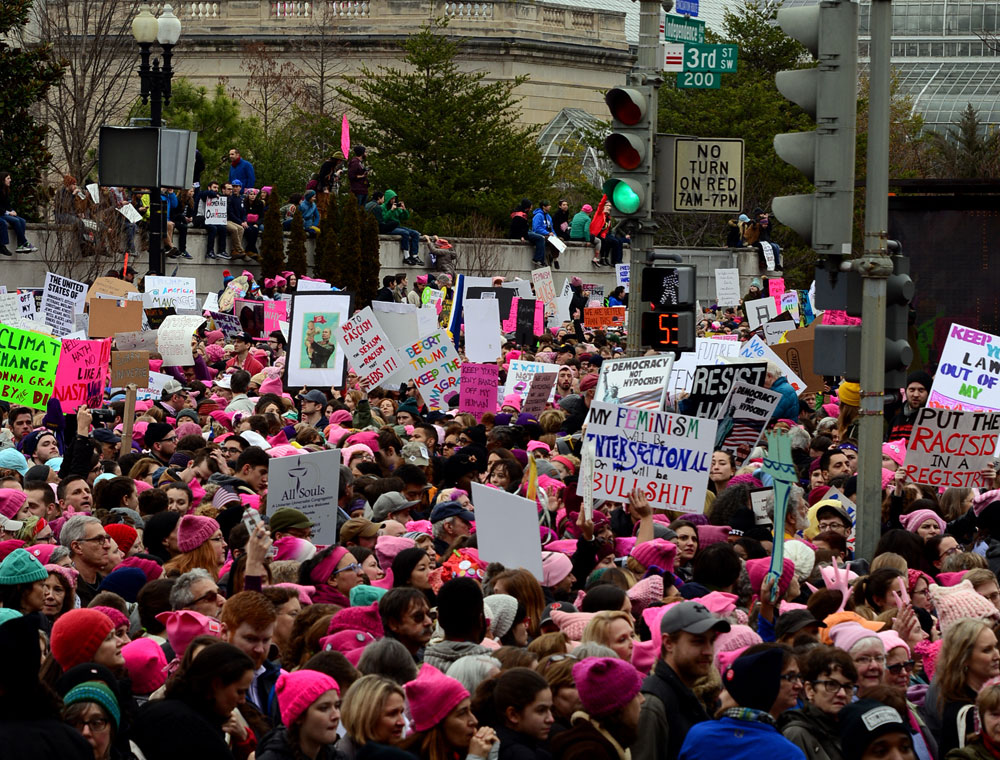
January 31, 2020; Washington Post
Fear of ruffling power’s feathers in Washington these days is palpable. Twice, exhibits designed to mark the 100th anniversary of women receiving the right to vote and tell the story of the ongoing struggle for women’s rights have been modified to avoid the ire of the president and his supporters. In both cases, leaders pulled between protecting organizational integrity and what they perceived as potential political blowback yielded to fear—and ethics and mission integrity were compromised.
Late last week, we learned that back in May, shortly before an exhibit entitled “Shall Not Be Denied: Women Fight for the Vote” was set to open at the Library of Congress, curators decided that a photograph of the January 2017 Women’s March in Washington was inappropriate. Rather than depict the massive crowd that turned out a day following the inauguration, they chose a picture of only eight marchers in Houston, Texas. The new picture chosen showed one sign, reading, “Fight Like A Girl.” The picture removed included many signs with messages challenging President Trump.
Kevin Carroll’s photo of the Washington march was initially selected because it captured the scope, size, and energy of today’s women’s movement. In an email to Carroll obtained by the Washington Post, Library of Congress senior exhibition director Betsy Nahum-Miller explained the Library’s thinking. “While the vast majority of the exhibition will focus on the years leading up to attaining the vote, the exhibit will also give visitors a sense of the ongoing struggle for women in the political, economic and social realms.”
“For that reason,” says Nahum-Miller, “we wanted to include an image from the 2017 March on Washington. We believe it captures the essence and energy of the march and serves as a contemporary representation of women using the power of protest and exercising their right to engage in American democracy.”
Just days before the exhibit was to open, though, Nahum-Miller informed Carroll that his photo was out. “I am so sorry that this happened and I’m very disappointed we can’t use your spectacular photo.” Library of Congress Spokesperson April Slayton explained the decision to the Washington Post:
Sign up for our free newsletters
Subscribe to NPQ's newsletters to have our top stories delivered directly to your inbox.
By signing up, you agree to our privacy policy and terms of use, and to receive messages from NPQ and our partners.
The Library of Congress strives to present historical exhibitions that are balanced and engaging for all visitors with diverse points of view and generally seeks to avoid content that would unnecessarily alienate visitors based on political views…vulgar language and political content was not appropriate for the Library’s exhibit.
Slayton says that Librarian of Congress Carla Hayden “was informed of the decision soon after and supported it.”
This mirrors language used by the National Archives when it sought to explain why it had doctored a similar photo at the entrance to its Women’s Suffrage commemorative exhibit at the end of 2019. In organizations whose missions were historic accuracy and preservation, the leaders in both cases chose to edit that history for fear that those in power might cut their budgets. James Grossman, executive director of the American Historical Association, described this dilemma in comments to the Washington Post: “Everybody who leads these institutions has to ask themselves, ‘In taking a principled stand, am I endangering the institution that I consider to be useful and essential to public culture?’ That’s a tough question.”
For the artist whose work is censored, the question is not so difficult. “I was a little embarrassed, a little hurt,” Carroll says. “I really wanted to be a part of it. I’ve looked again at the photo, and I don’t see anything over the top.” It’s also not that tough for those whose story is erased from the history being taught. Rinku Sen, co-president of the Women’s March’s board of directors, said in an email to the Post that “removing the anti-Trump references from images or choosing an image without such a reference obscures the fact that the Women’s March was a pointed oppositional action, not just a sweet expression of women’s empowerment. Public institutions have a responsibility to present us accurately.”
Protecting the financial and political strength of their institutions is the responsibility of organizational leaders. Worrying about how various segments of the community and key stakeholders will react is part of their jobs. But so too is defending their missions. The National Archives, after widespread reaction to its self-censorship, reversed course and displayed an unaltered picture. The Library of Congress has so far chosen to stand pat. Both organizations censored themselves without being asked to do so. Of course, power operates best when it remains invisible.—Martin Levine













